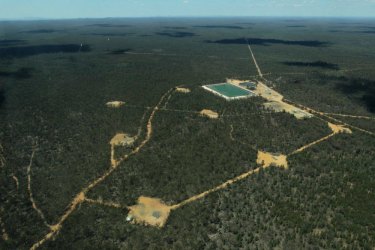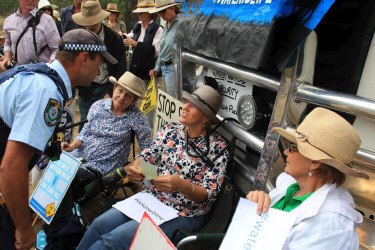Trojan horse fears after NSW government reveals gas exploration zone
Farmers and the gas industry have objected to plans by the Berejiklian government to reduce the areas where coal gas exploration can proceed, with one saying it’s a betrayal of promises and the other warning that consumers will have to pay for any restriction on new supplies of the fossil fuel.
Deputy Premier and Nationals leader John Barilaro released the Future of Gas Statement on Wednesday, saying land available for gas exploration would be reduced by more than three-quarters, killing off so-called zombie licences that have sat undeveloped for years.

More of this to come?: The Bibblewindi ponds, part of Santos’ Narrabri coal seam gas project, in the Pilliga State Forest.Credit:Dean Sewell
The permitted region in the Liverpool Plains and the Namoi valley would support Santos’s approved gasfield near Narrabri and potentially hundreds of jobs and $3 billion in revenue for state and federal coffers as part of a COVID-19 recovery plan.
Margaret Fleck, a grazier near Mullaley whose farm remains within the approved zone, said the new plan showed the government always intended for gas development to expand beyond Santos’s field.
“Narrabri was always seen as a Trojan Horse that open up vast areas†for development, Ms Fleck said. “It’s just confirmed those fears.â€
Ms Fleck said the decision also flew in the face of a promise made by Mr Barilaro prior to the recent Upper Hunter byelection that mining on the rich farming region of the Liverpool Plans would be extinguished “forever and a dayâ€.
Ms Fleck predicted farmers would continue to resist any expansion of the Santos project or other gasfields, and the two new pipelines proposed to link the region to markets: “We’ll see incredible landholder opposition to both of them.â€
NSW Farmers, meanwhile, said landholder certainty had been “vapourised†by the gas plan.
“The Liverpool Plains is a key food bowl with some of best the soils in the world,†NSW Farmers President James Jackson said. “The fragile and interconnected nature of its groundwater systems is the main reason why more coal mines have not been supported in these regions.â€
Mr Barilaro said far-western NSW, such as Broken Hill, had been excluded from exploration, and he also pledged that regions with gasfields would retain some of the revenue generated.
“We want to ensure communities where gas exploration occurs receive their fair share and that’s why I’m also confirming additional funding will be made available for these local government areas through a future round of Resources for Regions,†Mr Barilaro said.
Roy Butler, the Shooters, Fishers and Farmers MP whose electorate covers some of the permitted gas zone, predicted farmers in Wee Waa and Boggabri will “be out of their trees†in opposition to the plan.
Mr Butler also took exception to claims in the gas statement that the fossil fuel planned to be imported by Andrew “Twiggy†Forest at Port Kembla by 2023 and other terminals would be “unlikely to deliver gas into NSW at the same price as local productionâ€.
“Please show us how Narrabri will lower prices,†Mr Butler said, adding that it was more likely imports would “put another nail in the Narrabri coffin†because of the high cost of extraction and delivery.

Farmers say they won’t give up their efforts to stop coal seam gas development in their regions, and will also oppose gas pipelines linking any fields that proceed.Credit:Dean Sewell/Oculi
APPEA, the oil and gas industry lobby, was also disappointed with the plan, saying it would lock up most of the state from development and deliver “a body blow for local consumers, thousands of jobs, the environment and businessesâ€. Customers would be left paying well over $20 per gigajoule of gas.
“This shortsighted decision will mean higher gas prices in NSW are the norm, not the exception,†Ashley Wells, APPEA’s NSW Director, said. “Appeasement of vocal and extreme minorities will continue to mean that NSW will face ongoing economic and energy security risks.â€
Madeline Taylor, a senior law lecturer at Macquarie University and a member of the Climate Council, said it remained unclear whether the licences would actually be extinguished as the government only planned to amend the Mining State Environmental Planning Policy rather than legislating for their elimination.
“We’re creating a gas belt,†Dr Taylor said. “There’s no permanency in this for communities in terms of their protection from gas exploration and production.â€
Georgina Woods, a spokeswoman for the Lock The Gate Alliance, said the gas statement contradicted the government’s own net-zero emissions goal for industry with its prediction of long-term increases in gas use.
Ms Woods said the plans to develop more gas around Narrabri also contrasted with the International Energy Agency’s recent opposition to so-called green-field fossil fuel projects: “They very clearly said there should be no new gas developments if we’re going to achieve net-zero targets.â€
For its part, Santos said it was “disappointed that the NSW government sought to extinguish further areas with no regard to the investment that has already been madeâ€.
The company, which plans to drill 850 wells at its Narrabri gasfield, said it had amended its licence renewal applications to relinquish or surrender approximately 70 per cent of its exploration acreage, “far in excess of our statutory obligationsâ€.
“The only way to address gas shortfalls and price spikes at times of high demand is by developing local gas resources close to market instead of relying on imports from other states or overseas,†Kevin Gallagher, Santos’s Chief Executive Officer, said.
Peter Hannam writes on environment issues for The Sydney Morning Herald and The Age.
0 Response to "Trojan horse fears after NSW government reveals gas exploration zone"
Post a Comment